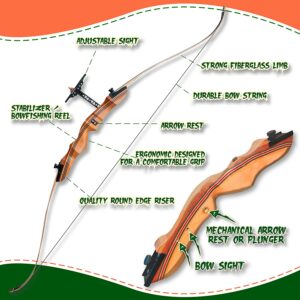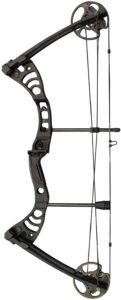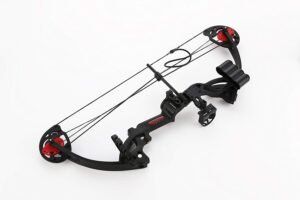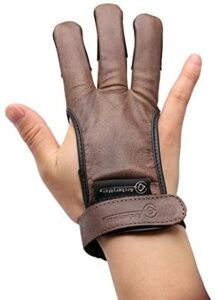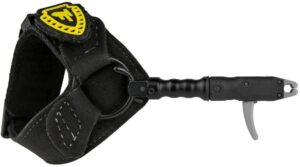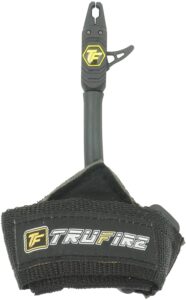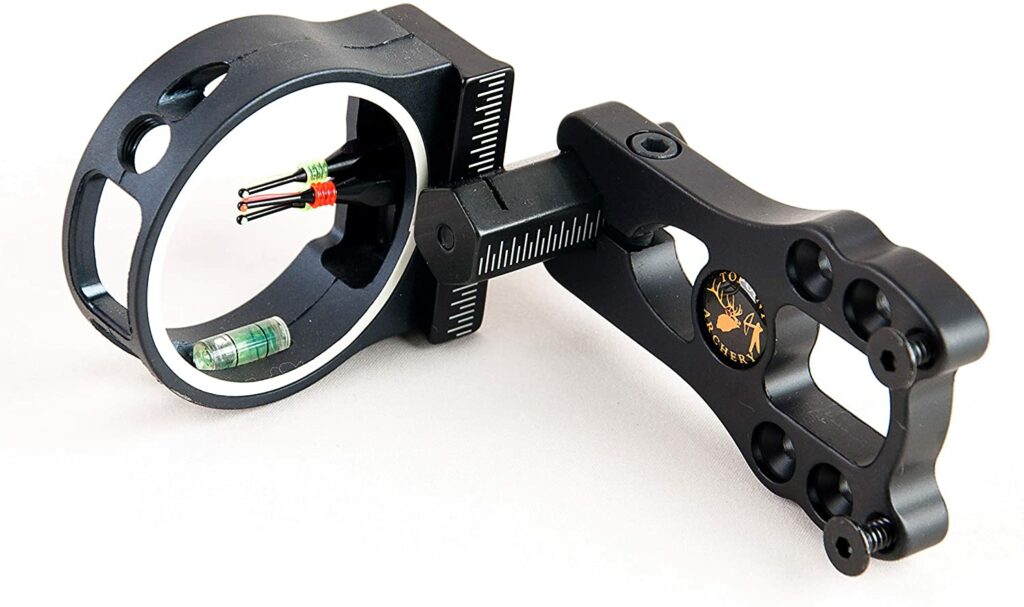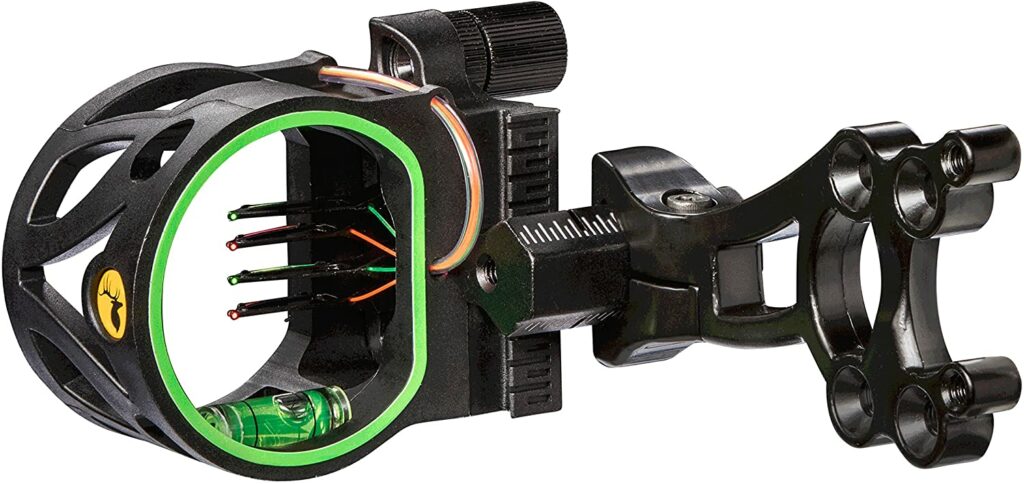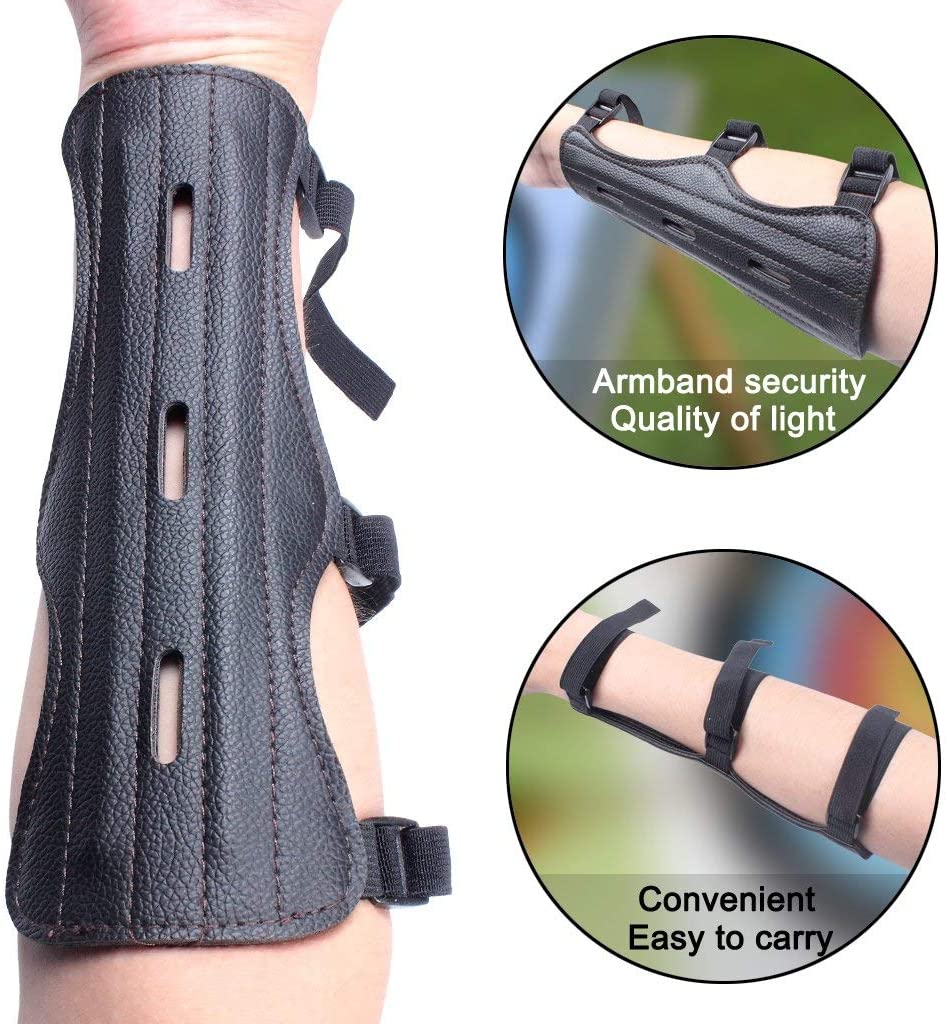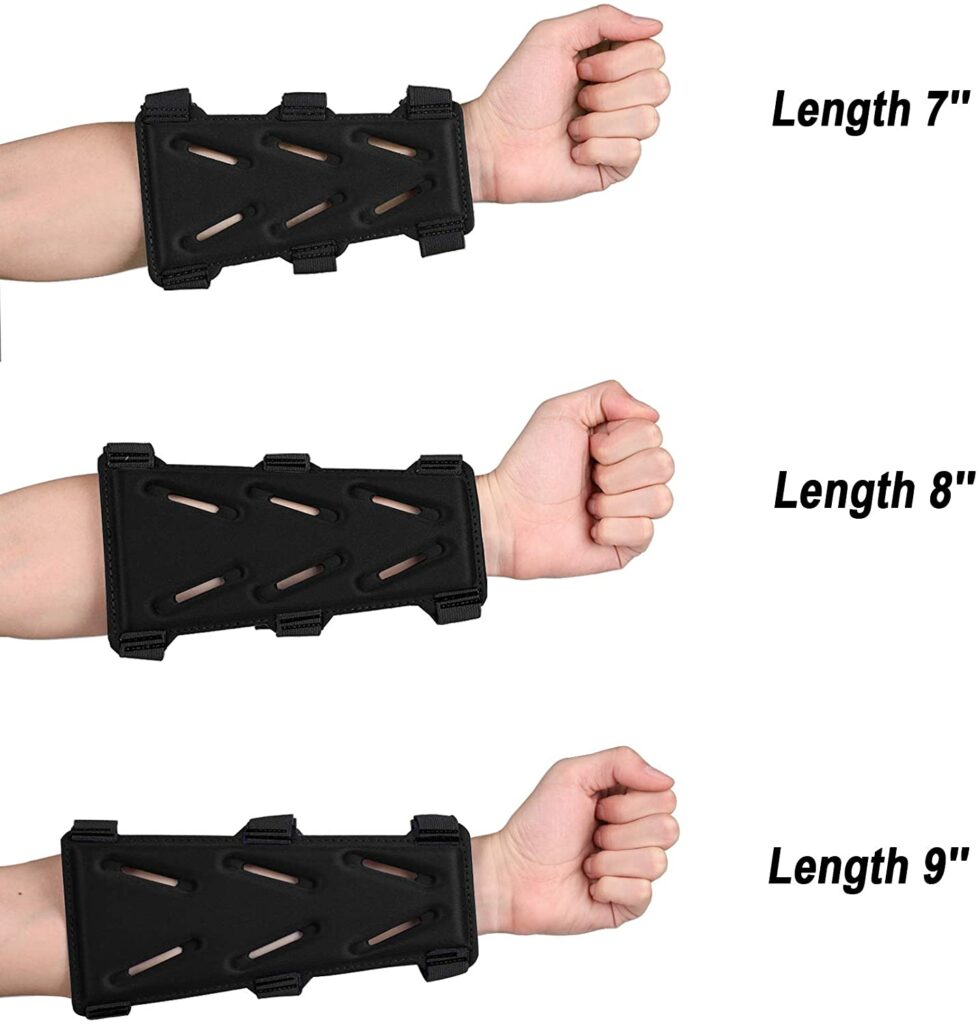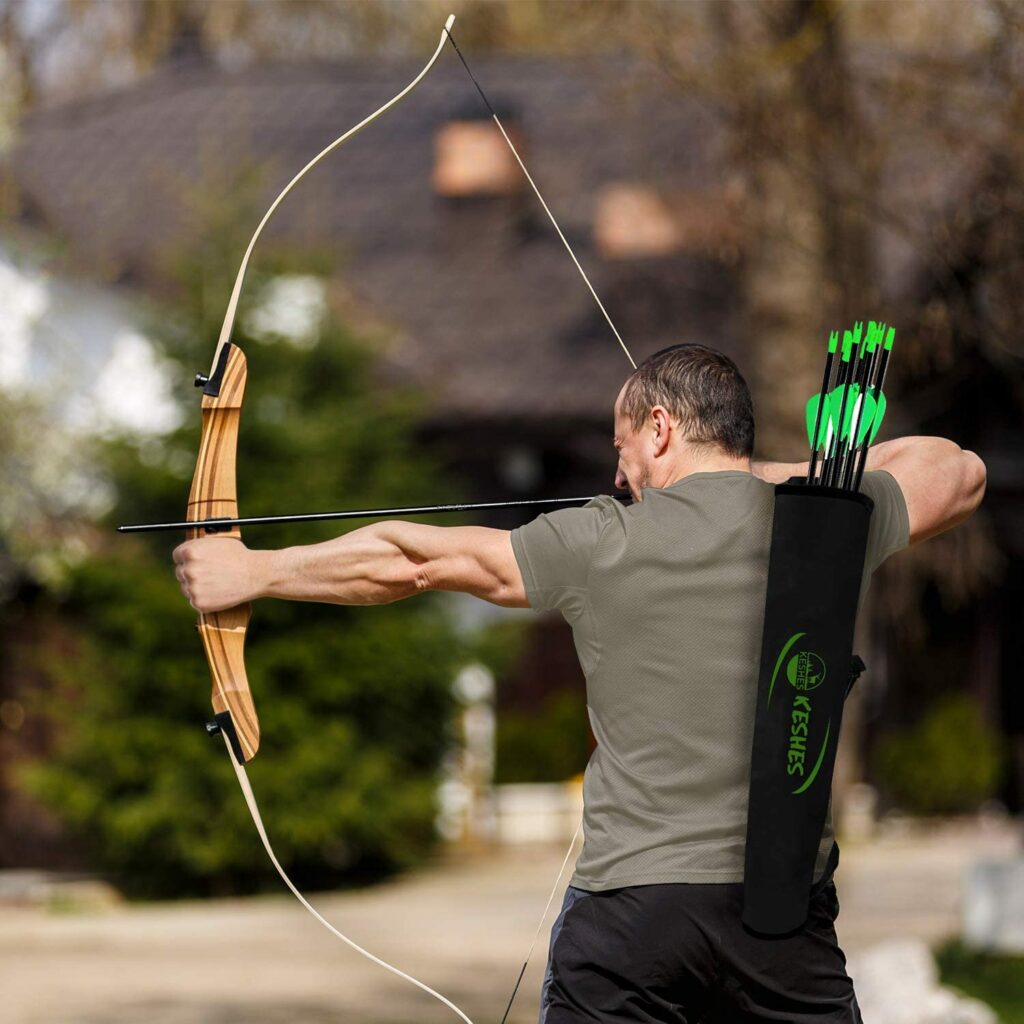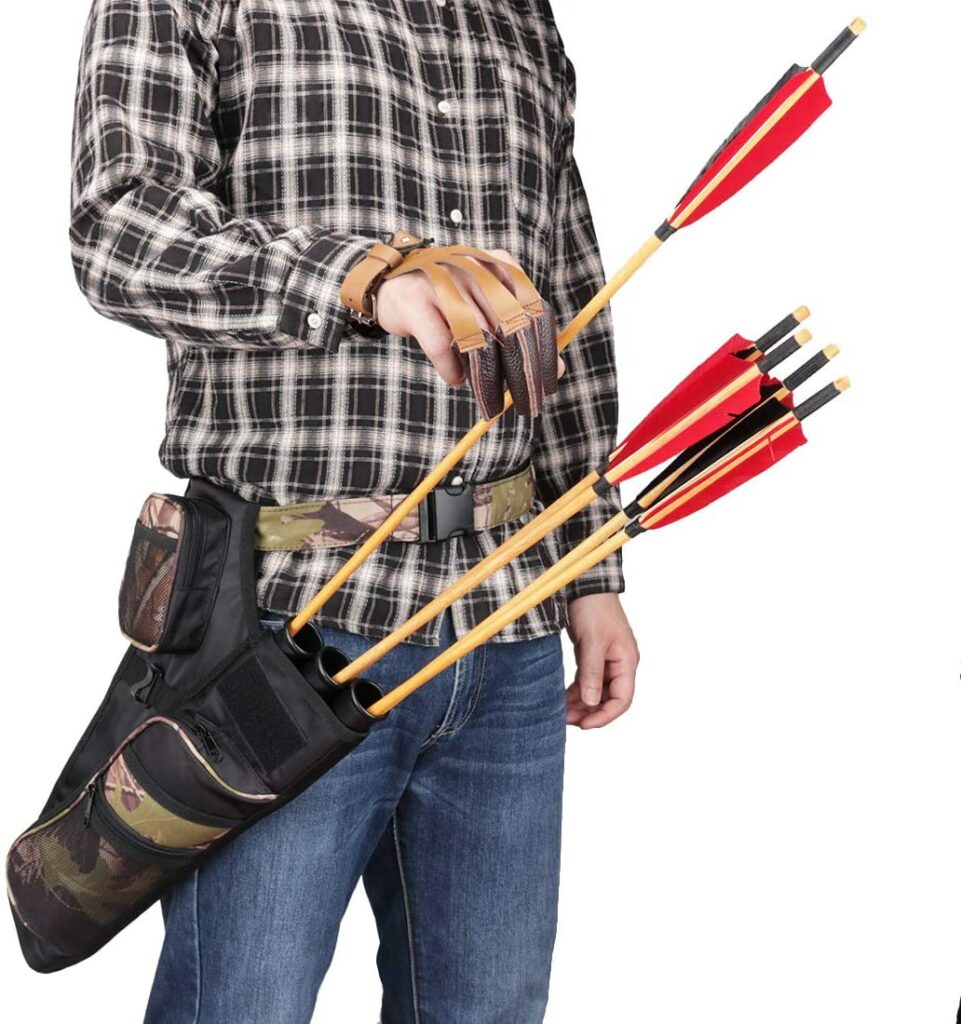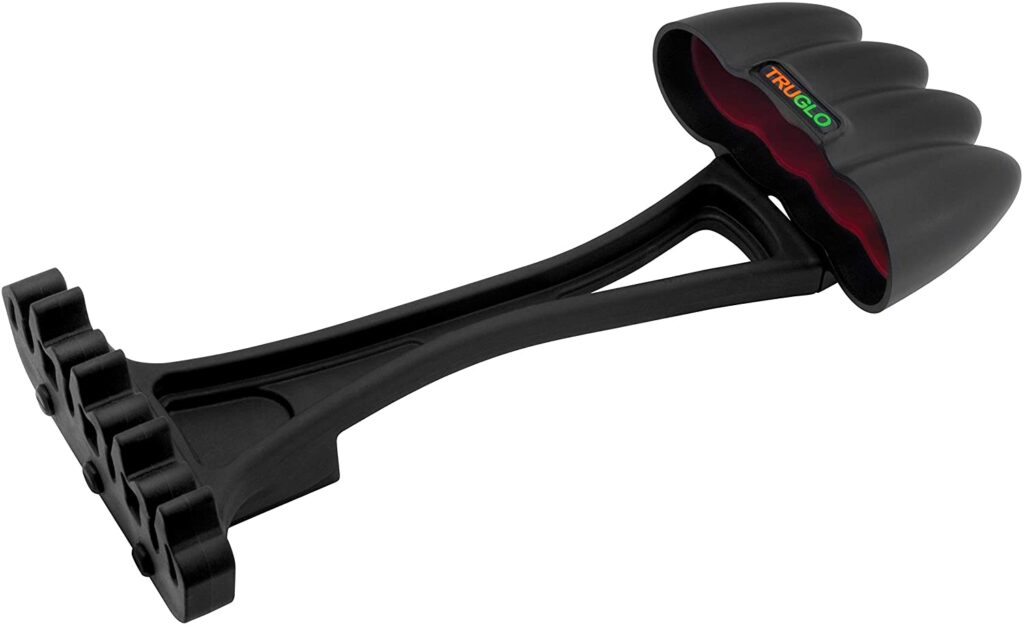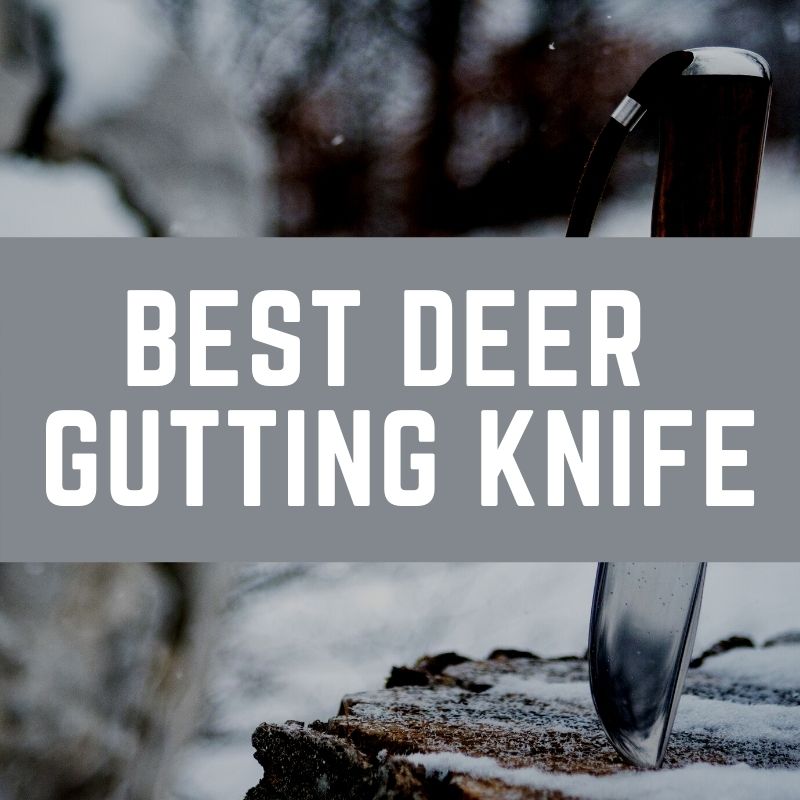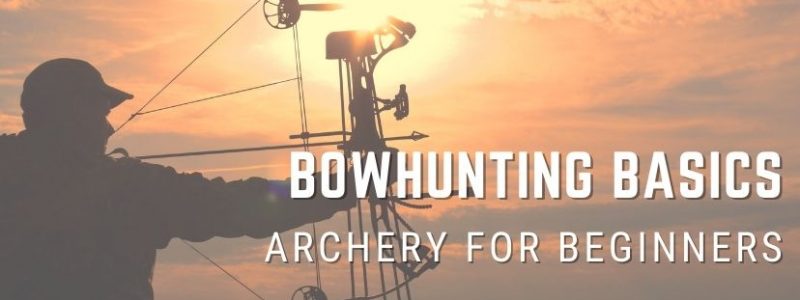
Have you been interested in bowhunting or archery for a while but you don’t know where to begin? We’re here to help you get started and become a pro! Bowhunting is an option many hunters choose and it can provide a great deal of enjoyment both in the woods and on the archery course.
We’ll break down everything you need to know, from what bow is the right one for you to where you can practice and what arrows you should select. Our bowhunting basics guide will help you get started with archery today so you can begin bowhunting next season.
Table of Contents
1) Buying the Best Bow for Beginners
- Recurve Bow vs Compound Bow
- Recurve Bow Overview
- Compound Bow Overview
- Measuring Proper Bow Length and Draw Weight
- Understanding Parts of a Bow
2) Bow Accessories
3) Selecting Your Arrows
4) Archery Fundamentals
- Technique and Form
- Follow Range Rules
- Clothing and Accessories
- Maintain Gear
- Never Dry Fire a Bow
- Safe Aim
- Are You Ready to Bowhunt
- Prep for Bowhunting
Buying the Best Bow for Beginners
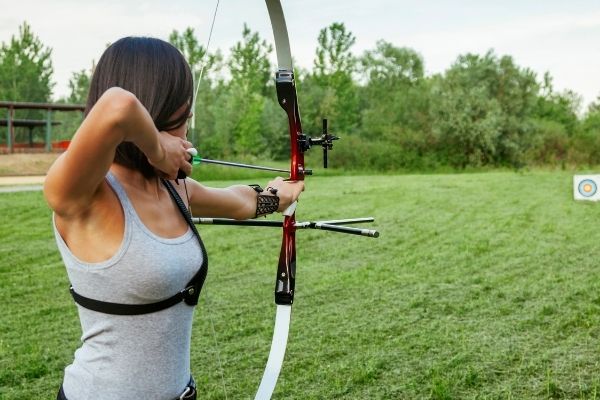
First things first — you’re going to need a bow to get started in bow hunting and archery. So what bow is the right bow for you?
There are two main types of bows you’ll be selecting from as a beginner: a recurve bow and a compound bow. As you advance with your archery skills, you may start to consider a longbow, crossbow, and more, but for now, we recommend sticking to either of these two models to start off – they are easy to learn the basics on and complement a beginner’s skillset.
When selecting which type of bow is right for you, remember there is no wrong choice: some hunters love the technique and design of a recurve bow, while others like the options a compound bow provides them. It’s up to you to decide if you want all the bells and whistles, something simple, more options, or a traditional design. In the end, you may end up learning on both and shooting with different bows based on the situation.
Recurve Bow vs Compound Bow
Recurve Bow

- Traditional design
- Heavier draw weight by design
- Fixed limbs require a new bow for varying draw weights (takedown limbs allow for flexible draw weights with the same bow)
- Flexible draw length
- Easy to assemble
- Shorter shooting distance
- More technical skill required
- Light but long
Compound Bow

- Modern design
- Lighter draw weight
- Adjustable draw weight with the same bow
- Fixed draw length
- May require a pro to assemble
- Longer shooting distance with more power
- Less technical skill required
- Weight varies, compact design
What is a Recurve Bow
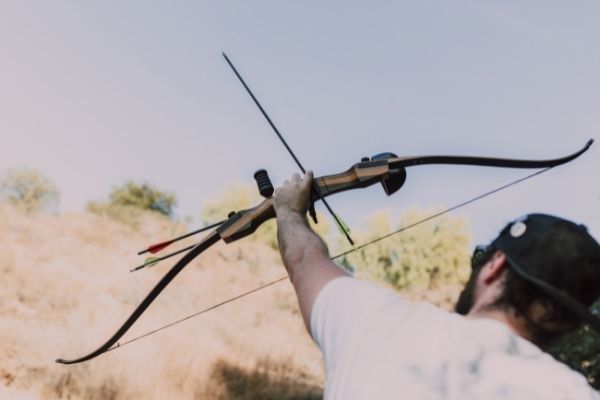
Recurve bows are a more traditional-looking bow and are favored amongst survivalists in comparison to a compound bow. While recurve bows are popular for target archery, plenty of skilled archers will use a recurve bow when hunting.
These are light, easy to carry, and can be extremely accurate once their technique is mastered. The learning curve can be steeper with a recurve bow vs a compound bow but is well worth it for the hunting benefits of having a light, easy-to-maintain bow on hand.
Despite being lighter in design, the simple structure requires a heavier draw weight so upper body strength is a must when using a recurve bow. If you don’t have that draw strength yet, don’t worry — you will build draw strength over time once you start practicing.
Another detail to consider is that recurve bows require you to be closer to your target vs a compound bow, because the shooting distance is shorter. For some, this could be an attractive reason to buy a recurve bow, based on where or how you like to hunt, but for others, a compound bow will be better simply for the longer shot.
Why Recurve Bows are Good for Beginners
- Easy to use
- Simple to measure for
- Less fine-tuning and upkeep
- Ready out of the box
- Primary use is target archery
- Traditional sportsmanship technique

Recommended Recurve Bows
When you’re ready to buy your first recurve bow, here are some popular and affordable models recommended by fellow archers.
Make sure to read the rest of our guide for how to measure for your bow properly before making the investment!
Samick Sage Takedown Recurve Bow
- Designed for novice to intermediate beginner archers
- Right and left handed draw options
- Lightweight
- Durable Maple wood
- Ergonomic design
- Attachment ready
- Max 28" draw length
- 25 lbs - 60 lbs draw options
- Detachable limbs for easy draw weight changes
TOPARCHERY Takedown Hunting Recurve Bow
- Designed for beginner to intermediately skilled archers
- Right handed draw option only
- High-strength casting aluminum riser design
- Strong fiber glass limbs with maple core
- Max 30" draw length
- 18 lbs - 50 lbs draw options
- Detachable limbs for easy draw weight changes
- Requires assistance and separately purchased bow string to assemble
KESHES Takedown Hunting Recurve Bow and Arrow
- Designed for adult and youth beginner to advanced archers
- Right and left handed draw options
- Lightweight
- Durable wood limbs with black fiberglass
- Comfortable grip design
- Attachment ready
- Max 28" draw length
- 15 lbs - 60 lbs draw options
- Detachable limbs for easy draw weight changes
What is a Compound Bow
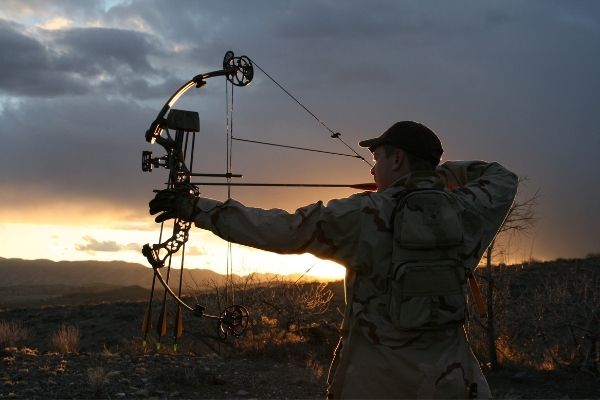
Compound bows have a more modern design and draw back differently. They use a pulley system that allows for the weight to “let off” at a certain point, giving you a lighter hold without losing power.
Compound bows are popular for hunting but there are plenty of archery competitors that use these, as well.
Compound bows are popular with hunters because they are light, compact, shoot a further distance with more power, and require less draw strength to operate. All of these details can help when hunting from a treestand. Compound bows are designed to accommodate various accessories, like scopes and sights. While these are more technical and will often require a pro to sight in properly, they are extremely accurate once properly fine-tuned.
With a compound bow, hunters have to be prepared to maintain their equipment with more finesse. Because there are more technical components, you will need to become experienced with the proper way to clean, repair, and store your compound bow. The draw is also set upon purchase, so you have to make sure you measure correctly before purchasing.
Some hunters prefer the look of a traditional bow, while overs prefer the modern design of a compound bow. With compound bows, you have more options and can customize your bow to work for you without having to worry about technical precision and draw strength on your end.
Why Compound Bows are Good for Beginners
- Easy to aim
- Once properly put together, simple to shoot
- Reliable accuracy
- Primary use is bow hunting
- Compact for easy carry and transport
- Shoots fast, powerful arrows
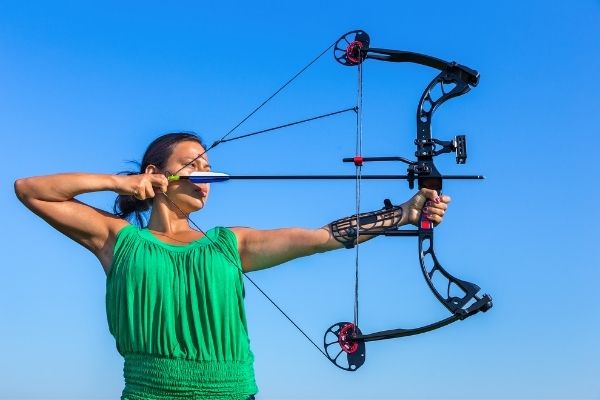
Recommended Compound Bows
Start comparing compound bows today so you’re ready to buy when the time comes! Remember to use our draw length and weight guide to help you invest in the right compound bow.
Southland Archery Compound Bow
- Draw Length: adjustable from 19" - 29”
- Draw Weight: 30-55 lbs.
- Archery and hunting bundle accessory packages available
- Sturdy and durable design
- Lightweight and compact
- No bow press needed to adjust draw length
- Highly recommended beginner package purchase
PANDARUS Compound Bow Archery Set
- Right handed and left handed draw options
- Draw length: 19”-28” adjustable
- Draw weight: 15-29lbs
- Lightweight design
- Designed for entry-level archers, adults and youth
- Complete archery bundle package available for purchase
- No bow press needed to adjust draw length
Sanlida Dragon X8 Compound Bow
- Adjustable draw length: 18-31"
- Draw weight: up to 70 lbs
- Adjustable draw length without bow press
- Beginner bundle package available
- Recommended bow for beginners to see them through advanced skills
- Incredible value for the cost: BEST bundle for value price
Measuring for Your Bow

Why an Accurate Draw Length is So Important
Do not guess, overestimate, or intentionally buy outside of your draw length.
When working with a compound bow, this is to ensure comfort and the ability to use the bow properly. Due to its pulley system, a compound bow is intended to only be shot at a full draw and will therefore stop at the draw length it is set at. Measure wrong or increase your draw length for a more powerful bow and you may buy a bow that doesn’t fit or work properly.
For recurves, you still want a proper draw length for fit and comfort. If you’re overextending your body to get a longer draw length, you may experience fatigue, inaccuracy, and less powerful shots.
The best way to measure for a new bow as a beginner is to visit a local archery shop. Although the measuring process is fairly straightforward, there are minor details that are important to not overlook. We’ve included a few at-home methods to help you measure so you have an idea of what you’ll be shopping for, but we recommend following up with an experienced archer so you start out with the right measurement and a proper fit with your first bow.
The other benefits of working with a local archery shop are the insights they will give you into finding the perfect bow that fits you specifically. Remember — a bow should be complementary to your body build and your draw strength. The bigger or more powerful the bow doesn’t really matter if you are unable to draw, aim, and shoot it comfortably.
Over time, your draw strength will increase and you can progress through more bow variations, but for now, stick with what is right for you at your current level to build the strongest foundation.
First: Measuring for Draw Length
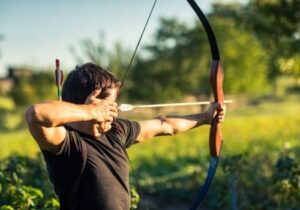
No matter what method you choose, always work with a professional, whether a friend or at an archery shop, to confirm your measurements before making the final purchase. This will ensure the right fit and save you the headache of working with a bow that isn’t right for you.
1) Armspan Method
This is the most popular method for measuring for draw length for a new bow. You will need a partner for this, so grab someone and a tape measure and you’ll be good to go.
- Stand with your back against the wall
- Outstretch both arms to the side with the palms facing forward — do not overstretch or focus on gaining a wide reach, stop where it is comfortable and natural
- Have your partner measure from the end of your left middle finger to the end of your right middle finger
There are two methods to get the final calculation:
- Divide the middle finger to middle finger distance by 2.5
Or
- Minus 15 from the total distance from middle finger to middle finger and then divide by 2
These numbers should be fairly close; if not, we recommend going with the first method, where you divided by 2.5. The final number will be the draw length you want when purchasing your bow.
2) Height Method
Draw length is ultimately dependent on your height. The arm span method works well because the full distance from your outstretched arms divided by 2.5 is very similar to going by your height. However, you can also measure based on your exact height.
- Measure your exact height (no fudging the numbers to make yourself feel taller, accuracy is more important)
- Convert your height entirely into inches
- Divide this by 2.5
- Round up to the fullest inch (26.7 to 27) and that is your draw length
3) Visit a Local Archery Shop
So how do they measure at a local archery shop? They have a tool! A bow tech will use a draw length indicator shaft that will get you the accurate length for your draw length. This is why we always recommend following up with a local shop before making the final purchase — they can confirm the numbers before you make an investment in your first bow.
Second: Determining Your Draw Weight
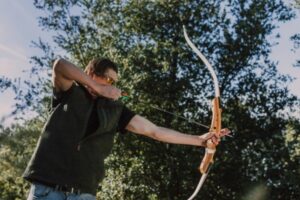
Although it’s tempting to buy above your comfortable draw weight for something that is more powerful, this will cause you an inability to use your bow properly. A draw weight that isn’t comfortable will leave you fatigued, may harm your ability to pull back properly, and can deteriorate your progress.
Remember that you want a bow that you can pull back comfortably and quickly several times in a row — a draw weight outside of your comfort zone will leave you struggling during the critical moment of a hunt.
Always buy where your draw weight is currently and know that you can increase it over time as your archery muscles develop naturally. Once you have mastered the basics and gotten accustomed to shooting a bow, you will be more prepared and stronger to increase the draw weight of your bow for more power.
How Draw Weight Works with Each Type of Bow
Compound Bows: Compound bows are designed to have your draw weight change and increase over time. You can use the same bow but adjust the draw weight as you become more skilled. The heaviest point of the draw weight with a compound bow is in the middle of the draw — before the pulley system kicks in to allow for a release of pressure.
Recurve Bows: There are two types of recurve bows you want to know about — those with fixed limbs and those with takedown limbs. Fixed limb recurve bows only have one draw weight, so as you improve you will need to purchase new recurve bows with a greater draw weight. Takedown limbs allow for a change in draw weight while still keeping the same bow but purchasing different parts. The draw weight increases on a recurve bow the further you draw it back, giving you a range of draw weights to work with.
Average Draw Weights
The only way to know for sure what draw weight is right for you is to get into an archery shop and work with a professional or sales team member to try out bows and get a feel for their weight.
Below we’ve included some of the average draw weights you can use to get an idea for where you will be. Remember: lower is better! Only being able to pull your bow a couple of times will ruin your archery experience and possibly cost you a hunt. It’s better to go lower and be able to pull back your bow repeatedly without wearing yourself out.
Man/Woman | Your Weight | Recurve Draw Weight | Compound Draw Weight |
Woman | 100-130lbs | 25 - 35lbs | 25 - 35lbs |
Woman | 130-160lbs | 25 - 35lbs | 30 - 40lbs |
Woman | 160lbs+ | 30-45lbs | 45-55lbs |
Man | 120-150lbs | 30-45lbs | 45-55lbs |
Man | 150-180lbs | 40-55lbs | 55-65lbs |
Man | 180lbs+ | 45-60lbs | 65-75lbs |
Understanding the Parts of a Bow
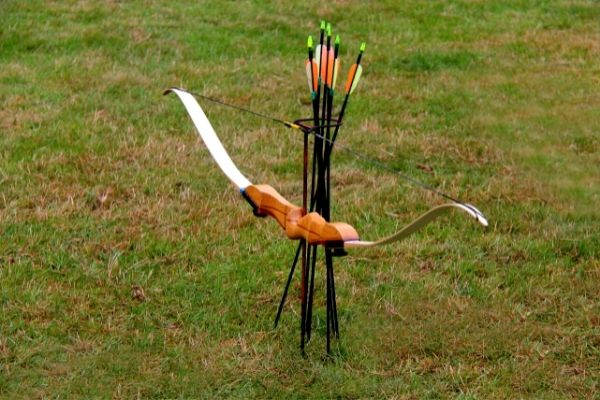
Whether you purchase a recurve bow or a compound bow, you want to know the components of your bow. Just like with a hunting rifle or any gun, understanding how your weapon is constructed is the best bet for maintaining safety.
Luckily, the basics of a bow are easy to understand and are universal from one bow design to the next.
- Riser, aka The Handle: The riser is where you will hold your bow and also where your arrow will rest; these look different from bow to bow and can become more complex, but these are the essential units and functions to understand
- Limbs: The limbs form the rest of the bow - a top limb connects to the top of the bow string and the bottom limb connects to the bottom of the bow strong; with some recurve bows, you will have “take down” limbs that allow you to swap out the limbs for a different draw weight
- Bow String: The bow string is critical because it is what shoots and launches your arrow
- Nock Point: Your nock point is where the head of the arrow rests on the bow string; this should always remain the same for consistent aim
Additional Accessories to Complete Your Bow
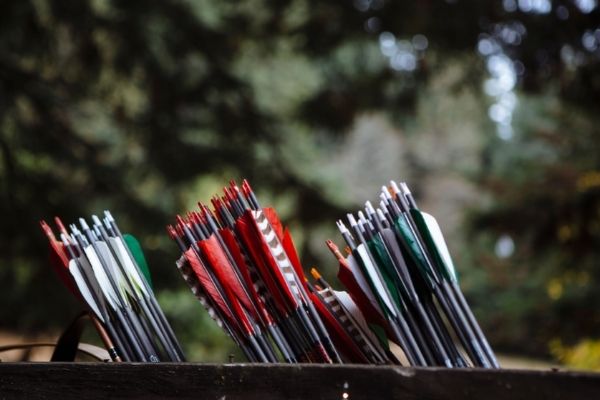
A bow on its own will work as intended and function just fine. However, there are several bow accessories you will want to invest in, regardless of whether you plan to hunt or compete at archery ranges.
These are the main bow accessories you will want to invest in as a beginner. What we have listed below will help with aim and accuracy, safety, comfort, and overall performance. Pair these with other popular archery and hunting accessories, like rangefinders, and you’ll be set up for success.
As with most aspects of bowhunting, it’s up to you which bow accessories you ultimately want. If something doesn’t work for you, omit it from your gear.
Arrow/Bow Release
A release on a bow is what you use to draw the string back and then release the arrow for your shot. Using your bare and exposed fingers is not recommended, as you will experience pain and inaccuracy from this method, incurring blisters and other injuries over time.
There are a lot of release options out there to choose from based on your bow type and personal preference. Here are some of our recommendations to get you started, but know that there are many other options worth exploring as you get more comfortable with your bow.
Archery Gloves & Recommendations
Bow glove releases are designed to protect an archer’s fingertips as they manually drawback and release their bowstring. Similar to leather working gloves, glove releases for a bow cover three fingers for the archer: their middle, pointer, and ring fingers.
These gloves help protect against blisters and other injuries that are sustained from firing a bow without a release aid.
Seektop Archery Gloves for Beginners
- Perfect for beginners, adults and youth
- Cow leather non-slip pads on fingertips
- Comfortable and durable for extended periods of shooting
- Soft polyester and elastic design allows for breathability and comfort fit
ArcheryMax Brown Leather Archery Gloves
- Cow leather and mesh material
- Comfortable fit
- Great for beginner archers and hunters
- Sizes run small, measure before ordering
Trigger Releases & Recommendations
An archery glove is considered a manual release aid — you are still using your fingers to draw back and release the arrow. By comparison, a trigger release aid is considered a mechanical release aid, because you activate a trigger that releases the bow.
The most common type of trigger release is a wrist strap with an index finger trigger release. These are great for beginners because they are intuitive to any who are familiar with shooting rifles or other guns. The strap goes around your wrist and connects to the trigger which holds the arrow.
There are many advantages to using a trigger release, including always having the trigger nearby (on your wrist) and the wrist strap provides some archers a better vantage when pulling back the bow.
Here are some of our top trigger release recommendations, but there are other designs worth exploring, including thumb release aids.
Bestseller: TruFire Smoke Compound Bow Release
- For use with compound bows
- Nylon material
- Foldback strap for no hassle use of hand
- Fits both left and right handed shooting
- Trigger is adjustable to fit any hand size
- Durable and long lasting
On a Budget: TruFire Patriot Trigger Release
- For use with compound bows
- Velcro fit
- Fits both left and right handed shooting
- Adjustable trigger sensitivity
- Steel trigger
- Durable and long lasting
Tab Releases & Recommendations
Tab releases are very similar in concept to archery gloves – protect the pads of your fingers while you manually draw back and release the arrow without the use of a trigger aid.
As opposed to gloves, however, you don’t have to wear these. Instead, they are positioned over the pads of your fingers, creating a stable base to pull back against.
- Best when used with recurve bows
- Made from durable full grain leather
- Hand crafted and hand stitched for long lasting durability
- Adjustable trigger sensitivity
Sights
Sights are important to help you aim and get consistency with every shot you take. Some sights need to be sighted in, as they come with various distance pins you can set. Others are more simple. As with most bow accessories, there are a range of bow sights to select from your personal shooting style.
Compound bows generally come with a basic sight that you can upgrade. Recurve bows are sold without a bow sight, but there are bow sights you can purchase specifically for a recurve bow. Almost all bows have pre-drilled holes to place sights. Here are some of our top recommendations for beginners.
Sight Recommendations
- Attachs to recurve and compound bows alike
- Can be flipped for either right-handed or left-handed bows
- Great entry level sight
- Bright, easily visible
- 5 fiber optic pins
- Bubble level
- Green hood accent
- Vibration reduction
- Rheostat light
- Attachs to recurve and compound bows alike
- Can be flipped for either right-handed or left-handed bows
- Great entry level sight at affordable price
- Aluminum design
- 3 fiber optic pins
- Bubble level
- Markings for elevation and windage
- Shake tested
- Best in bright light, not intended for low light shooting
- Designed for compound bows but can be used on a recurve
- Can be flipped for either right-handed or left-handed bows
- Bright, easily visible
- 3 or 4 fiber optic pin options
- Bubble level
- Green hood accent
- Rheostat light
Arm Guards
Arm Guards: Protection is a must when using a bow and arm guards will protect your inner arm from the release of the bow string. While this may not sound aggressive, the released bow string hitting your inner arm can result in pain and intense bruises. This is why arm guards are so popular and considered a must-have item.
Remember: you will be shooting your bow consistently and for long periods of time, what doesn’t hurt the first time will cause injury after repeated exposure, so invest now in arm guards.
Arm Guard Recommendations
2 Pack: Archery Arm Guards Leather Forearm Protector
- 2 pack
- Leather design and construction
- 3 Velcro straps for custom fit
- 2 stiffening rods prevent bowstring snap
- Thick construction is soft yet durable
- Fits adults and teenagers comfortably
Best Seller: KRATARC Archery Arm Guard
- 7, 8, and 9 inch length optons
- Blue, black, and brown color options
- 3 adjustable buckle straps for custom fit
- Vented design to keep forearm cool
- Made of durable fabric with scratch resistant design
- Comfortable and padded design
Arrow Quivers
You need a place to store your arrows, whatever bow you choose. There are various quivers to select from, including hip quivers, back quivers, and even quivers that attach directly onto the bow its self.
There are pros and cons to each type of quiver, so select the one that works best for you and pairs with your shooting style. Be sure to take in consideration other accessories you have on you, like bino harnesses for example, when selecting an arrow quiver.
Here are some of our recommendations for new archers to consider.
Back Quiver Pros, Cons, and Recommendations
Preferred by traditional archers, back quivers are the most notable type of quiver that people think of when picturing an arrow quiver.
Liked for their look more than their practicality, back quivers have some notable pros and cons to consider.
- Versatile option
- Does not get in the way during long walks or hikes
- Unable to tell which arrow you are pulling if you shoot with a variety
- Will not know how many arrows are left
- Bending over can easily dump the arrows
- Holds many arrows but often has minimal pockets and additional storage
Hip Quiver Pros, Cons, and Recommendations
Hip quivers, sometimes known as field or target quivers depending on how your arrows are stored, are a popular option among archers.
Hip quivers sit, you guessed it, on the hips and thigh. They can attach to a belt and work for both right-handed and left-handed shooters.
- A target hip quiver leans fletchings forward with points down
- A field hip quiver leans the fletchings backward with points down
- Easy to see, sort, and grab your arrows in a hip quiver
- Hip quivers sway and can get in the way during long hikes or walks
- Hip quivers do offer pockets and additional storage
Bow-Mounted Quiver Pros, Cons, and Recommendations
Bow-mounted quivers are a good option when you don’t want to attach a quiver to your body.
Bow-mounted quivers attach directly onto the bow and are most often see on compound bows.
- No need to wear a quiver
- May affect the natural balance of the bow
- Always know how many arrows you have left
- Easy to grab and at hand
- Some models are easily detachable to remove before shooting
Arrow Selection
Arrow selections affect how your hunt or target shooting goes just as much as the bow its self. Arrows come in different materials, lengths, and have a variety of arrowhead designs to select from.
What you decide to shoot with is an entirely personal choice and your arrow selection will vary based on your needs at the time. We’ll break down some of the pros and cons of popular arrow options below so you can start to experiment with what will work best for your situation.
Popular Arrow Point Options
Field, for target practice
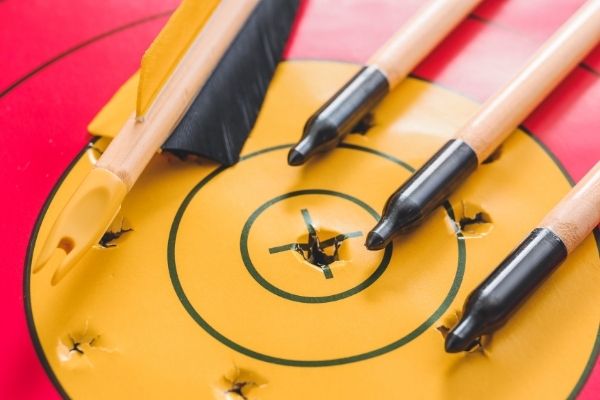
Field target points are sometimes known as bullet target points, although the tips vary slightly from model to model.
- Used for bag, foam, or grass-type targets
- Bullet points can be weight-matched to a broad-head point for hunters to practice with accuracy
Blunt, for small game

Blunt points are used when hunting small game and intended for bowhunting use over traditional archery use.
- Flat, blunt end kills small game from shock
- Choose from rubber, plastic, or steel design
- Intended for small game use including rabbits, squirrels, grouse, and other animals
Broadhead, for hunting big game

Broadhead points are dangerously wicked and made from metal. They are used solely for hunting big game.
- Made with metal blades that run alongside the broadhead
- Select from fixed blades, removable blades, or mechanical blades
- Choose from broadheads intended to cut or smash through big game targets
Arrow Length
Shorter
- Best for experienced archers and bowhunters
- Better accuracy
- Fly faster
- Poses biggest risk of injury to yourself or others
- Arrows can be “too short” and not allowed on ranges
Longer
- Best for beginners
- Less accurate compared to shorter arrows due to arrow flex
- Slower speed assists with learning and adapting
- Can cut longer arrows to custom fit your bow and shooting needs
Arrow Material
Carbon

- Most popular
- Strong
- Lightweight
- Durable
- Resistant to bends
- May crack - must check after hard impact misses
Aluminum
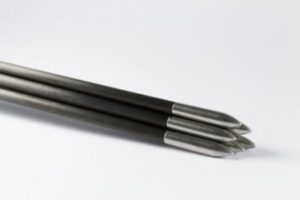
- Affordable
- Strong
- Lightweight
- Takes a hard impact to bend
- Not as durable as carbon arrows but a close comparison
Wood

- Classic arrow material
- Aesthetically pleasing
- Easily warps
- Less consistent accuracy
- Not as durable as other arrow materials
- Great for special occasions
Fletching
Plastic
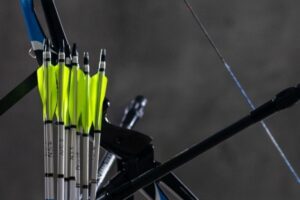
- Otherwise referred to as vanes
- Durable
- Waterproof
- Popular modern model
Feathers
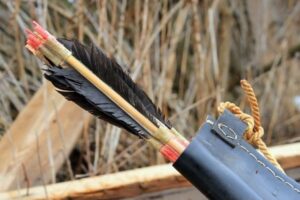
- Traditional arrow choice
- Great for competitive archers
- Preferred for indoor use
- Better for arrow stability
- Doesn’t catch on bow as they release
Understanding the Basics of Archery and Bow Hunting
Before you take your bow out on the hunt or to an archery range, there are a few rules and some etiquette you want to know.
These basics will help you connect with your local community, learn archery and bowhunting correctly, and will help prevent you from making mistakes or sustaining injuries. Always be mindful of yourself, your technique, and your skill level so you become a skilled archer safely.
Proper Technique is Critical to Safety and Success
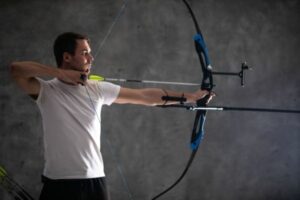
Not only does this keep you and others safe, but it will also increase your accuracy and consistency for every shot.
Stance
- Feet roughly shoulder-width apart
- Experiment with closed, open, and neutral hips to find your comfort zone
- Have a long, strong torso
- Do not lean into or away from the arrow (beginners will struggle with this the most)
- Keep shoulders relaxed and natural: do not overextend or draw in too tightly
Grip
- Have a loose, natural grip
- Your thumb pad should connect with the bow handle
- Do not handle it like a bat or torque it to the side
- Keep fingers relaxed throughout the shot
Anchor Point
- Find a natural anchor point for your face structure and bow design
- Recurve shooters often pull under their chin or corner of the mouth
- Compound bow shooters trace the jaw bone
Aim
- Relax the muscles you are not using to shoot the bow to reduce shake
- Line up your target with your sight or relevant distance pin
- If practicing for bowhunting, take the extra time to aim and confirm the shot
- Study your arrow groupings to see if your sights, stance, or other details needs corrected
Release and Follow-Through
- Proper follow-through greatly improves accuracy, especially in beginners
- Don’t drop your stance the moment you release the arrow
- Maintain proper posture and aim throughout the follow-through
- Wait for your arrow to land before lowering the bow
Range Rules Come First
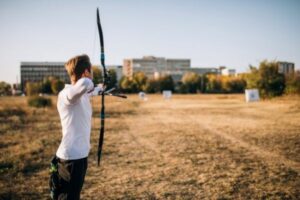
Range rules are set to keep yourself and others safe. Even if rules vary from range to range, you want to use the rules your range has set forth.
Keeping in line with range rules not only allows you to continue to practice at that range, it keeps you and others safe. Respect your range, fellow archers, and equipment by always knowing the rules of your location and following them closely.
Be Mindful of Clothing, Hair, and Accessories
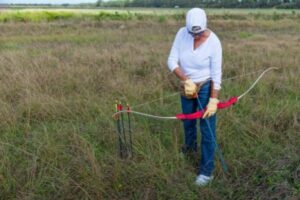
Loose or bagging clothing, long loose hair, and rings or other jewelry can all pose safety risks when shooting a bow and arrow. You want to check yourself to ensure nothing can snag, catch, tangle, or in any other way affect the arrow or bowstring.
A good practice is to wear jeans or similar fitting pants, closed-toed shoes, form-fitting shirts, no wrist or finger jewelry, and have hair your tied back or otherwise secured.
Maintain and Replace All Gear
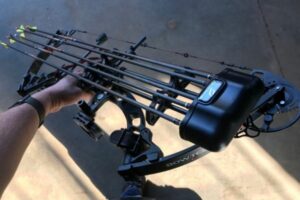
If you notice any wear and tear or inaccuracies with your gear, replace the faulty parts asap. Damaged gear is dangerous gear and poses a risk to you and others around you.
Regularly inspect your gear, ask experienced archers or bowhunters to go over it with you, and be prepared to stop using your gear until you can get it fixed if damage occurs. Some local archery shops will also be willing to inspect your gear, so utilize all your local resources to keep your bow functioning properly.
Do Not Dry Fire a Bow

What is dry firing a bow? It is releasing the bowstring without an arrow.
Dry firing a bow is risky and dangerous, putting both yourself and the bow at risk, as well as any bystanders around. Dry firing may break the bow, causing sharp pieces to fly off and in all directions.
If you are pulling your bow string back to test the weight or length, always place the bowstring back by moving it back into position with your grip vs firing it.
As With All Weapons - Aim Only at Your Target

In some cases, aiming your bow at another person at a range may be grounds for your removal from that range and you may be banned from going back. Put safety first, always, and only aim at your target. Pay attention when hunting and be aware of your surroundings.
Not Consistent? Not Ready for Hunting

Bowhunting before you are an experienced archer has several ethical and moral issues. You want to be sure that your aim and power are consistent when you plan to hunt and harvest an animal. If your aim is inaccurate you risk harming an animal but not killing it.
Only begin bowhunting when you are sure you can properly take down an animal without causing it suffering.
Remember to Practice in Your Gear
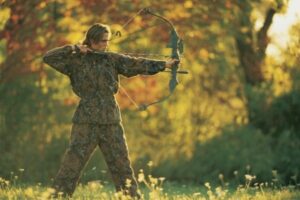
Shooting a bow in jeans and a t-shirt is a different experience from shooting your bow with all of your hunting gear attached and in bulkier clothing. As most hunters know, your hunting gear is almost always more than you expect it to be (check out our Ultimate Hunting Gear Guide for Beginners to get an idea) so you want to be as prepared as possible when positioning your bow around your other equipment.
To ensure a smooth hunt, get used to aiming and releasing in larger hunting clothing, placing an arrow with all of your gear attached, and maneuvering your bow and arrows silently when prepping for a shot.
Where to Purchase Your Bow and Arrows
Now that you’ve ingested all of the information we could possibly throw at you pertaining to bow and arrows, archery, and bowhunting, you are ready to purchase your first bow. The time has come!
You have a few different options for where to buy your first bow. We strongly suggest visiting a local archery store or hunting shop, so you can work with a pro one on one to make sure you get the right fit, draw length, and design for your needs.
If visiting a local archery shop isn’t an option, you can always buy online from some of our recommended links. As always, touch base with other archers and bowhunters in your community so you can get hands-on assistance when you’re just starting out.
Pro Archery Shops or Hunting Stores
text
Online Retailers
text
Where to Practice Archery and Bow Hunting
…

